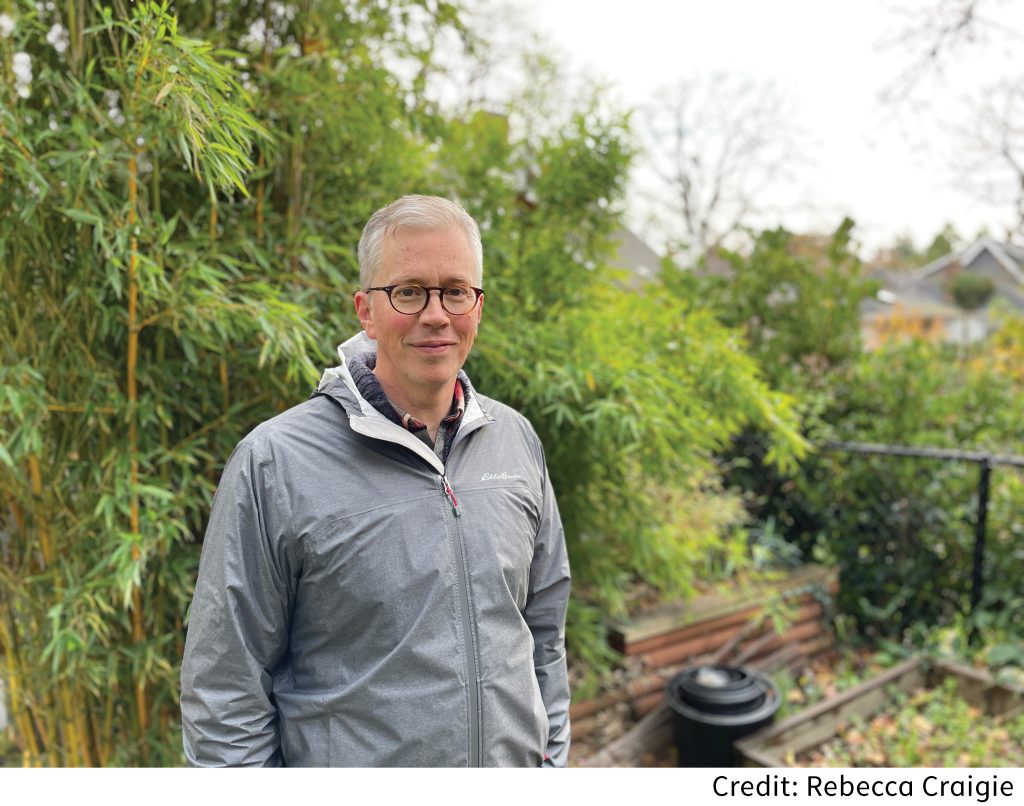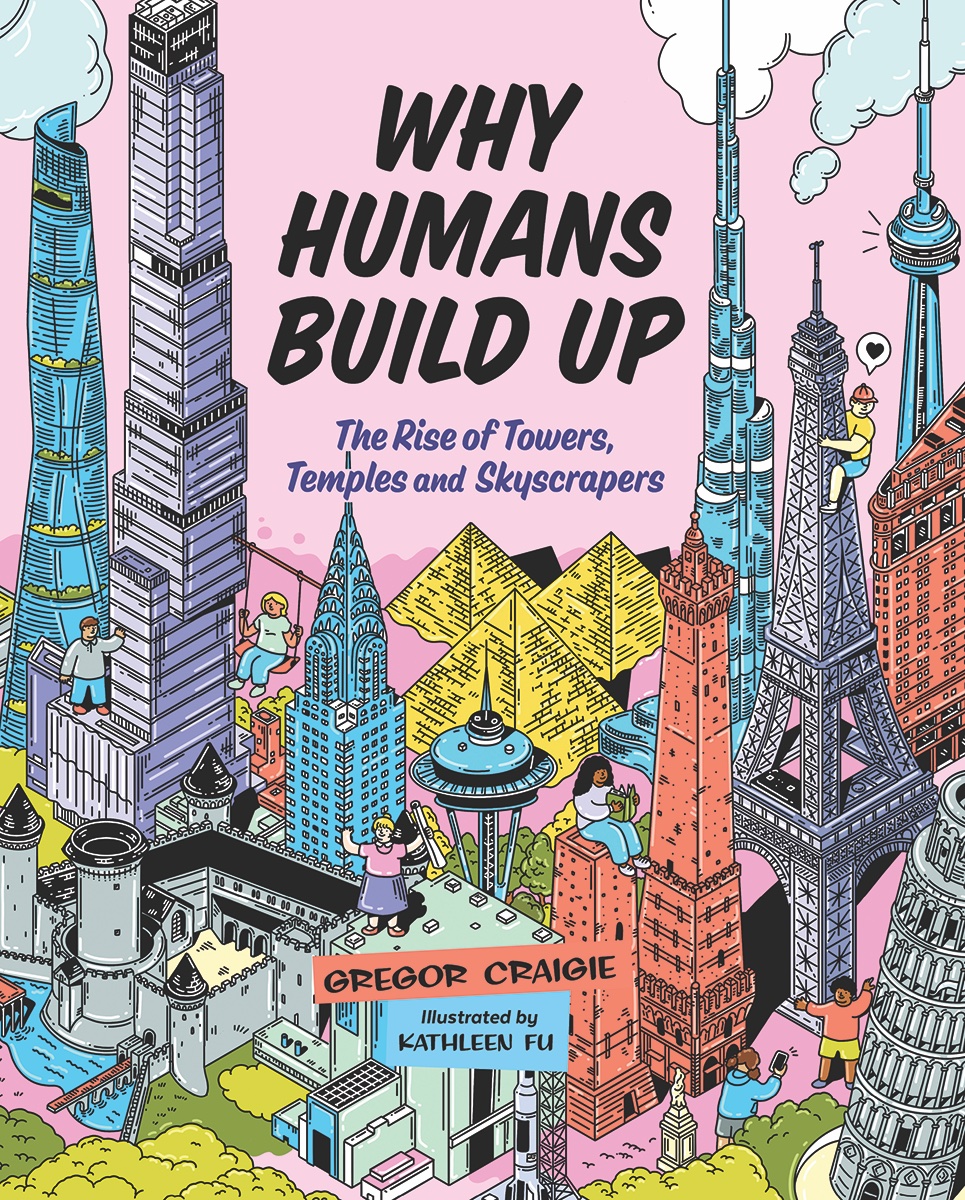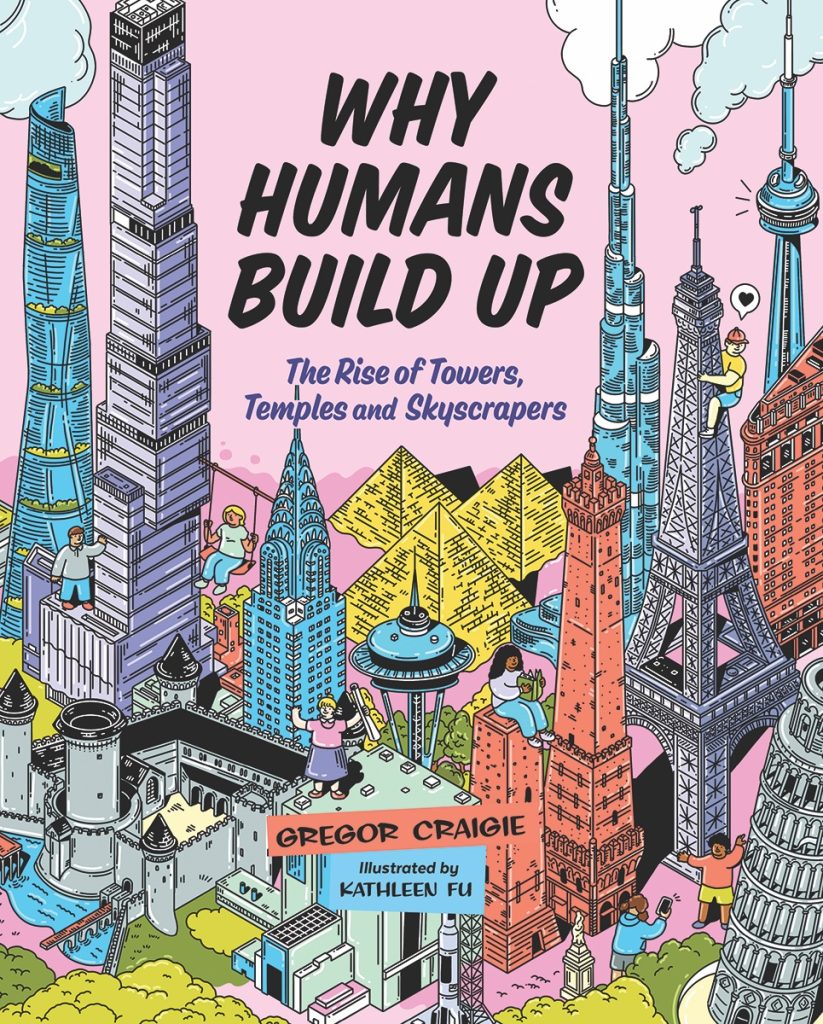Why did they build it so high?
People have been constructing tall buildings for thousands of years, for many different reasons. Castle walls kept people safe. Utility towers transmit TV and cell-phone signals. Observatories give people a bird’s-eye view of the world. Beautiful buildings stand out in the crowd. Skyscrapers provide housing for a lot of people. There are some good reasons for building up, and a few bad ones as well.
With a growing global population, we will need more and more space to live, learn and work in. But what does that mean for the health of the planet? Can we do it sustainably? Tall buildings may be part of the answer. From the Great Pyramids of Giza and the Leaning Tower of Pisa to the Burj Khalifa and the Shanghai Tower, Why Humans Build Up asks why and how we build higher and higher, and what that means for the planet.
In this Q&A, author Gregor Craigie shares the inspiration behind his new book, his favorite buildings and the coolest fact he discovered while researching.
1. Your new book, Why Humans Build Up is a nonfiction title for middle grade readers all about buildings and why we build them so high. What made you want to explore this topic and why specifically for this age group?
I wrote this book after answering countless questions about skyscrapers from my three sons. Of course, they asked which building was the tallest and how tall each skyscraper or tower actually is. Eventually, my youngest son asked me why the Burj Khalifa was so tall. I thought that was a great question. As we started reading and searching for answers online it became apparent there are many good reasons for building up, and quite a few bad reasons as well. All of my kids were interested in tall buildings from a young age, but they really wanted to dive into the details in this age category (9–12). Two of them are still that age and have been poring over the advanced reader copy of this book.
2. This is the first book in the new Orca Timeline series. Can you tell me a bit about the series and how your book fits into it?
Why Humans Build Up is the first book to be published in Orca’s new Timeline series. The series is a really interesting way to teach kids about history by focusing on one topic or theme and exploring how it’s evolved over the years. Why Humans Build Up looks at the history of why people building tall structures, starting thousands of years ago with the Tower of Jericho and continuing to the present day and beyond. I’m now writing another book for the Timeline series, tentatively titled Walls: The Long History of Human Barriers and Why We Build Them, that examines border walls and the history of people fearing other people. The book will present a fair view of walls, showing how they have helped keep some people and communities safe. But it will also show their shortcomings and discuss how many do more harm than good.
3. Your background as a journalist must have come in handy when writing this book. Can you describe how you approached your research? Knowing that this is a book for kids, did that affect your process?
I’ve been a daily journalist for radio, television, and digital news for more than two decades, so research is nothing new to me. I’ve really enjoyed all of the reading this book has required of me. I’ve also relied on direct interviews with experts, like architects and engineers, who have helped me better understand some of the key components of tall buildings, and pointed me in the right direction to find out more. Knowing the book is for kids, I remembered to ask my interviewees how they might explain certain concepts—like shear strength or sustainability—to children. Even as an adult, that often helped me gain a clearer understanding of the concept.
4. Your book examines the fascinating history of tall buildings but also looks to the future of how they might be part of the solution to a more sustainable planet. Can you share some examples of the innovative ways buildings are being used or built?
There are several more sustainable building techniques now being used in some buildings, including solar panels, solar chimneys, geothermal heating, wind turbine power generation, rainwater collection, and green living walls that help shade and cool a building naturally. There are also newer and more environmentally friendly materials that can be used during construction, like lower-carbon cement and steel that’s made with recycled materials, mass timber, and even Mycelium (the network of threads from which mushrooms grow) which can be shaped like wet concrete into firm building material.
5. What’s one cool and unexpected fact that you learned while researching this book?
Biomimicry! I was surprised by how much the natural world has influenced architects and engineers in their designs. For instance, the Eastgate Centre Building in Zimbabwe uses a natural cooling design that’s based on giant termite mounds. The insects build giant mud piles with tunnels on the inside and air vents outside that allow cold air in from below and hot air to be drawn out the top. That helps maintain a steady temperature, in both the mounds and the modern building, which uses only 10-percent of the electricity of a similar building with air conditioning.
6. There are some incredible buildings and structures featured in the book including the Great Pyramids of Giza, the Leaning Tower of Pisa and the Shanghai Tower. Do you have a favorite tall building? What about it do you love?
That’s a difficult choice because there are so many remarkable buildings around the world. If I had to choose just one, it would have to be the Woolworth Building in New York because it is so beautiful and gracefully designed that it looks more like a museum than an office building. It’s been compared to giant stone churches in Britain and Europe and dubbed the “Cathedral of Commerce” because of its intricate stone works and carvings. Even though the Woolworth Building is built around a relatively modern steel frame, it combines Italian, French and modern Renaissance styles and looks much older than almost any other skyscraper.
7. If you were a building, which one would you be and why?
I think I would be one of the more boring buildings featured in this book—the CIS Tower in Manchester, England. To be honest, the 25-story tower isn’t much to look at. It’s not ugly, but its appearance isn’t especially remarkable. What is remarkable, however, is how the CIS Tower has adapted with the times, and I’d like to think that I’m trying to do the same thing, especially when it comes to leading a more environmentally-sustainable lifestyle. The CIS Tower was first built in 1962, and won some architectural awards at the time. But when it was around forty years old, the building did something really impressive. It was renovated and covered in solar panels. The building is now known to many in Manchester as the Solar Tower, and it stands as an example that thousands of other tall buildings can not only use less energy, but can generate more of it to help in the fight against climate change.
8. Do you have a building bucket list? Which building would you most like to visit?
I used to travel a lot when I was a young journalist at the BBC World Service in London. These days I travel a lot less and only fly once in a blue moon. So I’m not sure I’ll make it there but if I could, I would love to visit the ancient Svan Towers in Georgia. They aren’t the tallest in the world—most are only three to five stories high. But some of these sturdy stone towers are more than 1,000 years old! I would love to climb to the top and take in the magnificent view of the surrounding Caucasus Mountains.
9. You have written another book about earthquakes. Are any of the buildings in this book at risk if there were a seismic event?
Sadly, some of these old towers are at risk. That’s not to say they will fall down any time soon. Many, like the Leaning Tower of Pisa, have survived several earthquakes. But the fact is that old masonry buildings composed of bricks or stone blocks are vulnerable if the ground beneath them shakes violently. I certainly hope none of them come down in a future quake, and it’s nice to see newer buildings—like the Tokyo Skytree, which has shock absorbers and vibration dampers to withstand major quakes—incorporating new designs and technologies to keep people safe.
Praise for Why Humans Build Up
★ “Finely detailed inside and outside…Broad in scope, perceptively organized, and enriched with fascinating entries.” –Kirkus Reviews, starred review
★“This great STEAM offering has multiple applications and will be useful for report writers and aspiring architects alike.” –Booklist, starred review
“One of the best of the genre of non-fiction books written to engage and educate readers of all ages…Fu’s colourful drawings add just the right touch of humour to prevent the text from becoming overwhelming…The right book at the right time for critical thinkers of all ages. Highly Recommended.” –CM: Canadian Review of Materials
“Recommended as an asset for both school and public libraries. Students who are fascinated by history and architecture will especially enjoy this book.” –School Library Journal
About the Author

Gregor Craigie is a writer and journalist. He wakes up at 3:45 every weekday morning to talk on CBC Radio in Victoria, British Columbia. Despite the early hours, Gregor loves his job because he gets to ask questions and write for a living. Before his current job at the Canadian Broadcasting Corporation, he worked for the BBC World Service in London and traveled to several different countries, telling stories for radio listeners. Why Humans Build Up is his first book for kids.



